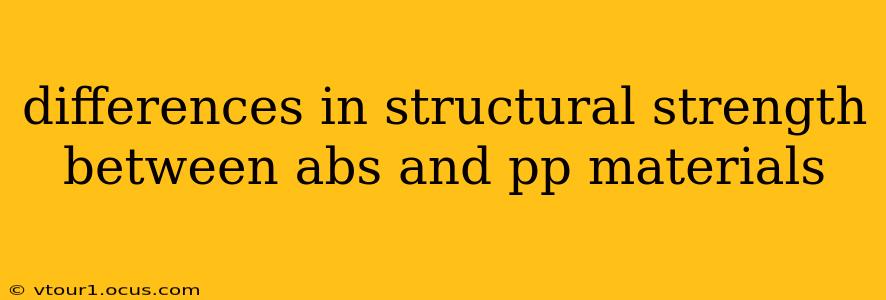Differences in Structural Strength Between ABS and PP Materials
Acrylonitrile Butadiene Styrene (ABS) and Polypropylene (PP) are both popular thermoplastic polymers used in a wide range of applications, from consumer products to automotive parts. However, their structural strengths differ significantly due to their chemical compositions and molecular structures. Understanding these differences is crucial for selecting the right material for a specific application.
What is ABS?
ABS is a terpolymer made from three monomers: acrylonitrile, butadiene, and styrene. This combination results in a material with a unique balance of properties. The acrylonitrile component provides chemical resistance and strength, the butadiene contributes impact resistance and flexibility, and the styrene enhances rigidity and surface finish. This synergistic effect makes ABS a strong, tough, and versatile material.
What is PP?
Polypropylene (PP) is a thermoplastic polymer made from the propylene monomer. It's known for its relatively low density, good chemical resistance, and high impact strength. Different grades of PP exist, offering variations in stiffness, flexibility, and heat resistance. Homopolymer PP is stiffer and more brittle than random copolymer PP, which is more flexible and impact-resistant.
Comparing Structural Strength: ABS vs. PP
The structural strength of both ABS and PP depends on several factors including the specific grade, processing method, and geometry of the part. However, some general comparisons can be made:
Tensile Strength: ABS generally exhibits higher tensile strength than PP, meaning it can withstand greater pulling forces before breaking. This superior tensile strength makes ABS suitable for applications requiring high structural integrity under tension.
Impact Strength: Both materials exhibit good impact resistance, but PP, particularly the copolymer grades, often surpasses ABS in this area. PP can absorb more energy before fracturing, making it ideal for applications prone to impacts or shocks.
Flexural Strength: ABS typically displays better flexural strength (resistance to bending) than PP. This means that ABS parts can withstand more bending stress before failure.
Hardness: ABS is generally harder than PP, meaning it resists indentation and scratching more effectively.
Heat Resistance: PP generally possesses a higher melting point and better heat resistance compared to ABS. This makes PP suitable for applications involving higher temperatures.
H2: What are the factors influencing the structural strength of ABS and PP?
Several factors can influence the final structural strength of both materials:
- Grade: Different grades of ABS and PP exist, each with slightly different properties. Selecting the right grade is crucial for optimal performance.
- Additives: Additives like fillers, plasticizers, and UV stabilizers can significantly affect the mechanical properties of both materials.
- Processing: The manufacturing process, including injection molding parameters, can impact the final strength and quality of the part.
- Part Design: The geometry and design of the part play a crucial role in determining its overall structural integrity. Stress concentrations and thin sections can weaken the part, regardless of the material used.
H2: Which material is stronger, ABS or PP?
There's no single definitive answer to this question. The "stronger" material depends on the specific application and the type of stress the part will experience. ABS generally offers better tensile and flexural strength, while PP often boasts superior impact strength. Consider the specific load conditions – tensile, compressive, impact, flexural – to determine which material is better suited for a given application.
H2: What are the typical applications of ABS and PP?
ABS: Due to its balance of properties, ABS finds use in various applications, including:
- Automotive parts (interior trim, dashboards)
- Appliances (housings, covers)
- Pipes and fittings
- Toys and recreational products
PP: PP's high impact strength and chemical resistance make it suitable for:
- Packaging (containers, bottles)
- Automotive parts (bumpers, interior components)
- Medical devices
- Textiles (fibers, fabrics)
By understanding the nuances of the material properties of ABS and PP and considering the specific demands of the application, designers and engineers can select the material that best meets the performance requirements and maximizes the structural strength of the final product.
